#blogging essentials for beginners
Text
Essential Blogging Tools for Beginners
Are you just starting out as a blogger? Not sure which tools you need to get started? In this video, we'll go over the essential tools every beginner blogger should have in their toolkit. From blogging platforms to keyword research tools and everything in between, we'll give you a rundown of some of the must-have tools for a successful blog.
Whether you're a beginner or an experienced blogger, these tools will help you create high-quality content and grow your audience. So if you're ready to start your blog journey, tune in and learn about the essential tools you need to succeed!
#blogging#blogging tips#blogging for beginners#how to make money blogging#blogging tools#blogging tools for beginners#blogging tools 2022#blogging tools 2023#essential blogging tools#essential blogging toolkit#blogging toolkit#must have blogging tools#must have blogging toolkit#blogging toolkit for beginners#blogging tips for beginners#blogging tips and tricks#blogging tips 2022#blogging advice#blogging essentials for beginners#blogging basics for beginners
0 notes
Text
Best Snorkeling Gear for Travel
If you’re heading out on a vacation or a fun adventure and need the best snorkel gear for travel, you’ve come to the right place. The sets listed are perfect for those who are starting out and those who are more experienced. And those looking to save money will definitely find budget-friendly options. While some resorts will lend you snorkeling gear for a price, buying your own will ensure that it fits properly and the gear is clean.
Beginner Snorkeling Gear for Travel at Budget-Friendly Prices
Cressi Palau SAF Set

The Cressi Palau Short Fin Set is a good bet for novice snorkelers. This one has been on the market for over two decades. Since it’s for beginners, it only comes with a few features – like offering a panoramic view – but it’s a simple option that works well underwater. It has a silicone skirt to ensure there won’t be any leaks, and the Supernova “dry” snorkel keeps water out of the breathing tube. It also comes with a storage bag, so it’s easy to carry. Most reviewers note that it’s comfortable and easy to use. You can find this one on Amazon for $75.00.
Seavenger Aviator Snorkeling Set with Gear Bag

If this is your first time snorkeling and you’re wondering if you’ll use the equipment long-term, an excellent no-frills option would be the Seavenger Aviator Snorkeling Set with Gear Bag. The kit includes a beginner-friendly dry-top snorkel, mas, short fins, and a mesh carrying case weighing only about two pounds. There are a lot of different colors and sizes available, so it’s a great choice whether you’re looking for one for yourself or a child (currently at $42.99).
Best Snorkeling Gear for Kids

Talking about best snorkel gear for travel, if you’re heading out with your little one, this adorable set by Mares is a great choice. It comes in three colors for boys and girls. It’s comfortable, affords the protection they need, and is available at Amazon for $42.98. Most reviewers love it because it’s good quality; the flippers are comfortable, the snorkel has a splash guard, and it comes with a backpack.
Best Snorkeling Gear for Travel – For the More Experienced Diver
Phantom Aquatics Rapido

This set comes with a panoramic mask, and features tempered glass, expanding your field of view to see more while diving. The snorkel offers superior dry performance and a removable mouthpiece. This set also comes with an EZ Equalize nose pocket, which allows you to adjust to the sea pressure. The dry snorkel keeps water out and is comfortable.
This is considered by many a highly quality set at a reasonable price. You can pick this one up at Amazon for $73.29. It also comes in various colors, so you’ll surely find something that meets your preferences.
Cresi Big Eyes and Supernova Dry

Another great option is the Cresi Big Eyes and Supernova Dry. This one is more expensive; you can find it on Amazon for $62.95, but it has some neat features. The first is the ‘Big Eyes’ on the mask. It’s an inverted tear-drop lens to make downward visibility easier and manage your bc-mounted gear. Also, the mask is made from high-grade silicone, so you don’t have to worry about leaks. The Supernova dry is another cool feature that has a dry-top valve. It seals the breathing tube when submerged under water. If any water does get it, there is a lower purge valve so you can quickly expel it. Many people like this set because it’s comfortable and easy to use.
Continue reading on: Best Snorkel Gear For Travel
#travel blog#travel essentials#travel guide#travel diary#places to explore#travel destinations#travel gear#travel and tourism#travel goals#snorkeling#snorkel gears#snorkeling tips#snorkeling gears#snorkeling gears for beginners#snorkeling gears to buy#travel gears and essentials#travel tips#travel gears#in view adventures
0 notes
Text
Want a Thriving Vegetable Garden on Terrace: Do These 5 Essential Steps
Welcome to the world of Gardenholic! Live better, Plant Better! In this blog post, we will embark on a green journey, exploring the Want a Thriving Vegetable Garden on Terrace: Do These 5 Essential Steps.
In the hustle and bustle of busy life, a terrace vegetable garden is not just a hobby, but a sanctuary. It’s a place where you can grow your own food, reconnect with nature, and even reduce…

View On WordPress
#10 gardening tools#10 gardening tools and their uses#5 essential steps to a thriving terrace vegetable garden essay#balcony gardening#Best essential gardening tools for home gardening#Best essential gardening tools for home gardening in india#best fertilizer for organic gardening#best flower plants for terrace garden#best vegetable plants for terrace garden#best vegetables to grow for beginners#cheap terrace garden ideas#conclusion of blog post#disadvantages of terrace gardening#essay on terrace gardening#Essential gardening tools for home gardening in india#gardening#gardening ideas for beginners at home#Gardening tips#gardening tools#gardening tools names with pictures#growing vegetables on terrace in india#hand tools for gardening#homemade organic fertilizer for vegetables#How can I improve my terrace garden?#How can I make my terrace garden beautiful?#how do chemical pesticides affect plants#How do i organize my terrace garden#How do I organize my terrace garden?#How do you make a terrace garden for beginners?#How do you set up a terrace vegetable garden?
0 notes
Text
Does Auto Blogging Still Work in 2023? If Yes, Then How?
As the world of digital marketing continues to grow, content creation has become a critical component of any successful plan. Creating high-quality content, on the other hand, requires time and effort, and many website owners and bloggers struggle to meet the expectations of regular content development.
This is where auto blogging, a way of creating content utilizing automated tools, plugins, and software, comes in.
What is Auto Blogging?
The technique of producing and posting blog entries automatically using software tools is known as auto blogging.
These technologies automatically collect content from many sources, such as RSS feeds, news sites, and other blogs, and then integrate and post it on your blog or website.
Content spinning, which creates original content by rephrasing previous content, is another aspect of auto blogging software.
Does Auto Blogging Still Work?
Irrespective of the drawbacks, yes, auto blogging is an efficient approach to creating content, especially when done effectively. Choosing the correct niche and keywords is one of the secrets to effectiveness.
By focusing on a certain niche and employing targeted keywords, you can generate content that is relevant and beneficial to your audience.
Another key issue is the quality of the content sources you employ. Rather than depending exclusively on automated techniques, integrate high-quality information sources such as trustworthy news sites and industry-specific blogs.
This will guarantee that your content is useful and intriguing, rather than merely a rehash of previously published content.
Continue Reading
#top digital marketing blogs#blogs about digital marketing#best blog digital marketing#digital marketing blogs for beginners#digital marketing transformation#digital marketing essentials#digital marketing quiz
1 note
·
View note
Note
Do you have any recs for beginners who want to write poetry? I love your blog so much!
there's a list of starter poetry recommendations for reading poetry here. For writing poetry I would recommend essays and nonfiction by poets: Upstream by Mary Oliver, Still Life with Lemons by Mark Doty, Now and Then: The Poet's Choice Columns by Robert Hass. If there are specific poets you like and admire, I would read their interviews to see how they themselves approach poetry and writing. I would also subscribe to Devin Kelly's Ordinary Plots substack, Padraig Ó'Tuama's Poetry Unbound (substack and podcast), and the On Being podcast's interviews with poets. There's also this section on The Poetry Society of America which features poets and writers interacting with either their own work, other's work, or simply discussing different aspects of writing and experiencing poetry.
I would also recommend really familiarising yourself with the technical aspects of poetry: poetic structures, rhyming schemes, language and all its textures etc., because those are the essential building blocks more than anything else. Practice writing poems following established formats: try your hand at an abcderian poem, or a sonnet, or a tanka, or a villanelle--the structural limitations are a good way to force yourself to really think about what you want to say and how you want to say it.
At the end of the day, the most important thing if you want to write is to read widely, and read often--and practice and practice and practice again. Learning to write anything is like training a muscle and you have to train and work it consistently. Hope this helps and best of luck with your writing endeavours anon 🤍
580 notes
·
View notes
Text

✨ Simple Gif Colouring for Beginners ✨
I wrote up my basic gif colouring process for a friend recently, but a couple of people here mentioned they'd also find it helpful! so, as requested, this is a beginner-friendly walkthrough of the way I colour my gifs :) it's aimed at brand new gif makers with no prior experience with photoshop or photo editing.
when I first started gif making I found colouring and photoshop in general suuuper daunting, so I've tried to simplify everything here as much as possible. hopefully this will be relatively easy to follow and not too intimidating!
a couple of things to begin with:
I'm only talking about colouring here - this is not a full gif making tutorial. I've linked to some of my favourites of those here!
I personally like to make bright, 'clean' looking gifs with vibrant but natural colours, so that is the style of colouring this tutorial is geared towards. most of gif colouring is subjective and about personal taste - the only thing that I'd say is possible to get wrong is skin tones, which I talk about a lot in this guide.
as I mostly gif Thai dramas, most of the advice is geared towards colouring for East Asian/South East Asian skin tones - but the techniques should be fairly universally applicable (and here are some tutorials that talk about gif colouring for other skin tones).
I'm not an expert! I'm not claiming this is the best or the only way to colour gifs - it's just how I do it.
this post is very image-heavy. if the images aren't loading (or the gifs are running slowly or cutting/looping weirdly), then try viewing the post in its own tab (rather than on the your dash or someone's blog) and refreshing the page.
okay, full walkthrough beneath the cut!
contents:
1. intro
a. natural gif colouring goals
b. very very basic colour theory
2. super simple colouring (the essentials)
a. curves
b. selective colour (and skin tone correction)
c. hue/saturation
d. saving and reusing colouring
e. another simple colouring example
3. other adjustment layers
a. brightness/contrast
b. levels
c. vibrance
d. colour balance
e. channel mixer
4. troubleshooting
a. curves
b. saturation
5. fin!
1. intro
the colouring part of gif making can be super overwhelming, especially if (like me when I first started!) you're completely new to photoshop and/or have no experience with colour theory or photo/video editing.
if you're opening photoshop and making gifs for the first time, I highly recommend getting used to making a few basic, uncoloured gifs to begin with. just to practice, rather than post anywhere (though you can always come back and colour them later if you want) - but it'll make the rest of the process much easier if you're already beginning to get used to working in timeline mode of photoshop. give yourself a bit of time to practice and get a feel for things like how many frames you tend to like in a gif, where you like to crop them for the best loop, what kind of aspect ratio you like etc* - so that you're not trying to navigate all of that for the first time on top of everything else!
* frames: for me between 60-90 frames is ideal, but 40-120 frames is the absolute min-max I'd personally use in a normal gifset
loops: for the smoothest loops, try to avoid cutting someone off mid-movement or mid-word if possible.
aspect ratio: for full-size (540px) gifs, I tend to go for either 8:5 (slightly 'skinnier' gifs), 7:5, or 5:4 (particularly big, thick gifs lmao)
✨ natural gif colouring goals
part of what can be so daunting about starting gif making is not knowing where to start or what you want to achieve. this is definitely something that gets easier with practice - the more gifs you make, the more you'll get a feel for what kind of look you like and the more instinctively you'll know how to get there. it also helps to see if any gif makers you like have made "before and after colouring" posts - these can help with getting a sense of the kinds of changes made through gif colouring. here's one I made!
in general, I like to make my gifs bright and 'clean' looking, with vibrant but natural colours. these are the things I'm usually hoping to achieve with colouring:
brighten dark scenes
remove muddy, yellowish lighting or filters
saturate colours
correct any skin lightening filters or overexposure
make lighting and colours as consistent as possible between gifs within a single gifset, especially gifsets featuring gifs from multiple scenes/episodes/videos
this guide is focusing on natural colouring, but of course there are many cool ways to make stylised/unnaturally coloured gifs. imo you'll need to master these basics first, but if you want to learn how to do things like change the background colour of gifs or use gradients or other cool effects, then @usergif's resource directory has loads of super helpful tutorials!
✨ very very basic colour theory
[disclaimer! I don't know shit about fuck. I do not study light or art. this is just an explanation that makes sense to me exclusively for the purposes of gif making.]
the primary colours for light/digital screens are red, blue, and green. having all three colours in equal measures neutralises them (represented by the white section in the middle of the diagram).
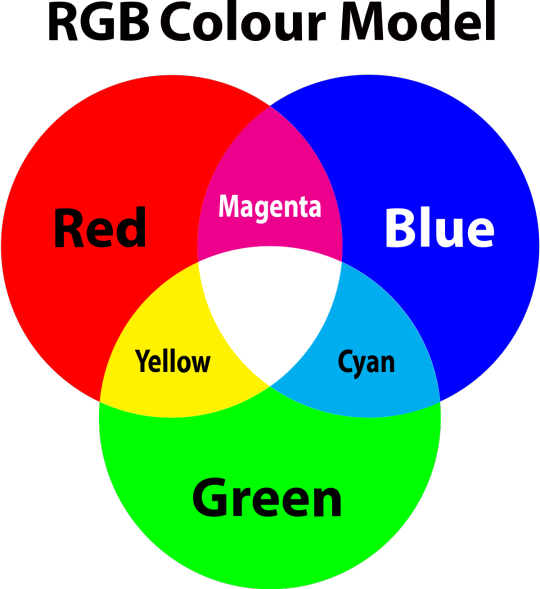
so to neutralise a colour within a gif, you need to add more of the colour(s) that are lacking.
in practice this usually means: the scene you want to gif is very yellow! yellow is made of red and green light, so to neutralise it you need to add more blue into your gif.
it can also mean the reverse: if you desaturate the yellow tones in a gif, it will look much more blue.
looking at the colour balance sliders on photoshop can make it easier to visualise:

so making a gif more red also means making it less cyan.
removing green from a gif means adding magenta.
taking yellow out of a gif will make it more blue.
tl;dr:
neutralise yellows by adding blue (and vice versa)
neutralise reds by adding cyan (and vice versa)
neutralise green by adding magenta (and vice versa)
2. super simple colouring (the essentials)
starting with a nice sharpened gif in photoshop in timeline mode. (these are the sharpening settings I use!)
some scenes are much harder to colour than others - it helps to start out practising with scenes that are bright/well-lit and that don't have harsh unnaturally coloured lights/filters on. scenes with a lot of brown/orange also tend to be harder.
I usually save a base copy of my gif before I start colouring just in case I end up hating it, or find out later that it doesn't quite fit right into a set and need to redo it etc.
so here is my base gif!

it's an okay gif, but it has a bit of a yellow tint to it that I want to reduce.
colouring is easiest to do in adjustment layers, which can be found under layer -> new adjustment layer - or for me they are here:
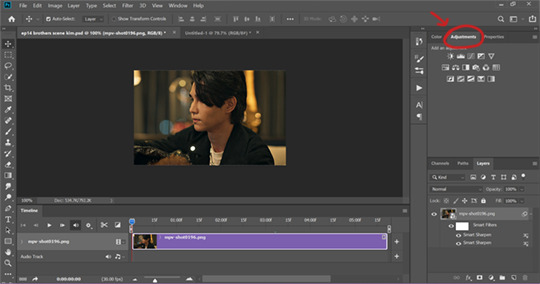
there are lots of different types of adjustment layers that do lots of different things - but for me the absolute essentials for colouring are curves, selective colour, and hue/saturation.
I also use brightness/contrast, levels, exposure, vibrance, colour balance, and channel mixer sometimes, depending on the gif - but I use curves, selective colour, and hue/saturation on every single gif.

✨ curves layer
the first thing I always do is a curves layer. when you first open one it will look like this:
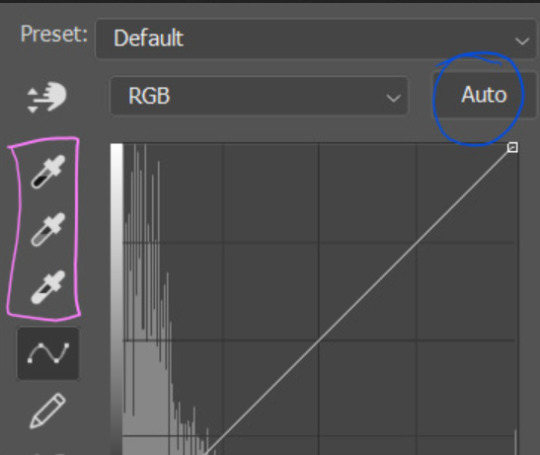
first I usually click the ‘auto’ button, just to see what happens. sometimes it makes a big difference (it usually brightens the gif a lot) - but on this gif it didn’t do much.
if it had made the gif look nicer then I would have kept it and added a second curves layer on top to do the rest of these steps.
the next step is selecting the white and black points with the little eyedropper tools.
the bottom eyedropper lets you pick a white point for the gif. click somewhere super light on the gif to see what happens - for this gif, I clicked on the lampshade on the left. if it looks weird, I just undo it and try somewhere else - it usually takes a few goes to find something that looks good.
here's what that did to the gif:

then I pick the top eyedropper and use it to pick a black point by clicking somewhere really dark, again playing around until I find a black point that looks good.
here's what the gif looks like after picking the white and black points:

this can take some experimenting, but you can make super easy drastic changes to your gif just with this. in this case, the curves layer took out a lot of that yellowy tint.
and this is what the curves graph looks like now:
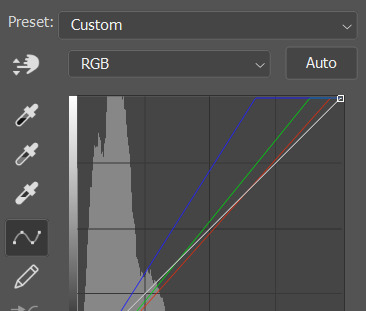
you can click and drag those lines to make further changes if you want - I usually leave them alone though. the colours of the lines indicate which colours have been changed in the gif - for example, you can see from that steep blue line on the graph that blue has been added to neutralise those yellows.
next I usually do another curves layer and just press the ‘auto’ button again to see what happens. usually it brightens the gif a bit more, which I like.
‼️if nothing is working: usually with a bit of fucking about a curves layer works well - but sometimes you can’t find a good white and black point anywhere, and instead your gif turns wacky colours and nothing looks good. this happens more often with very heavily colour tinted scenes :( the troubleshooting section at the end goes over some options, including starting with a levels layer instead.
✨ selective colour (and skin tone correction)
skin tones are made up of a mixture of yellow and red.
removing yellow (or adding blue or red) to a gif will make the skin-tones too red - and removing red (or adding cyan or yellow) to a gif will make the skin-tones too yellow.
adding blue to this gif with the curves layer took out the yellowy tint, which I wanted - but it also took the yellows out of Kim's skin tone, which I don’t want. so I need to put yellow back into the skin tones specifically - without putting it back into the rest of the gif.
selective colour layers let you select an individual colour and adjust the levels of other colours within that colour. you can change how yellow the green shades are, or how much cyan is in the blues, for example.
I need to add yellow back into the red tones to correct the skin tones on this gif. this is the case for most gifs in my experience - the vast majority of the time, unless a scene is very heavily tinted in another colour, a curves layer will add blue/remove yellow.
in the 'colors' dropdown, select the 'reds' section and drag the 'yellow' slider higher - this will add more yellow into just the red shades within the gif.

the amount of yellow you need to add back into the reds depends on how much yellow was taken out of the gif initially - I just play around with the slider until it looks right. if you're not sure, it helps to have some neutrally-coloured (not white-washed!) reference photos of the people in your gif to compare to.
here's the result. Kim's skin is a lot less pink toned and much more natural looking:

✨ hue/saturation
this adjustment layer lets you adjust the hue and saturation of the gif as a whole, and also of each colour individually.
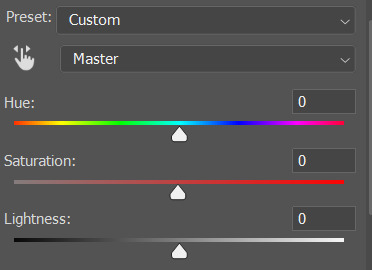
I don't use the hue or lightness sliders unless I'm trying to do something more complicated with the colouring.
clicking the dropdown menu that says 'master' lets you edit the saturation of each colour individually. this is useful if your gif is still super tinted in one colour.
I thought the yellows on this gif were still slightly too bright, so I switched to the yellow channel and desaturated them slightly. (remember if you do this then you need to go back to selective colour and add more yellow into the red skin tones to balance out the desaturation!)
then I increased the 'master' saturation of all the colours to +5:

I usually find the right amount of saturation is somewhere between +5 and +12, but it depends on the gif.
‼️if the gif feels undersaturated, but the saturation slider isn't helping/is making the colours worse, try a vibrance layer instead.
done!
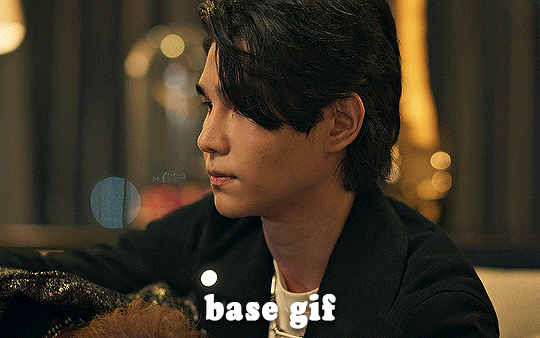
✨ saving and reusing colouring
you can copy and paste adjustment layers between gifs to make your colouring even across each of your gifs for one scene - so if you're making a set of multiple gifs of the same scene, or you think you might want to gif the same scene again in the future, you can save it as a psd so you can reuse the colouring again later.
each gif's colouring will then still need tweaking - different cameras/angles/shots of the same scene can still start out with slightly different colouring.
I recommend uploading the gifs as a draft post on tumblr so you can see what they all look like next to each other and catch any inconsistencies.
✨ another one! (speedrun!)

HI KEN!
the white point for the curves layer was in the window behind them.
the curves layer removes the muddy yellow tint, but again it makes their skin tones (especially Ken's) very red toned, which is adjusted by the selective colour layer.
3. other adjustment layers
imo many many gifs can be coloured really nicely with just those three adjustment layers, but some need different adjustments.
✨ brightness/contrast
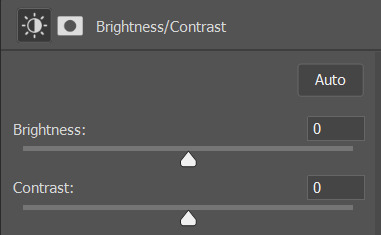
pretty self explanatory!
I personally usually avoid using the 'brightness' slider because I rarely like the effect - I only tend to use the 'contrast' one.
the 'auto' button is sometimes useful though, especially if you’re struggling with the curves layer.
✨ levels

levels alters the white and black points of the gif, like curves - but unlike curves it doesn't also alter other colours.
use the sliders beneath the graph to alter how dark/light the gif is. you can slide the black slider further to the right to make the blacks darker, and the white slider to the left to make the whites lighter.
levels is a good place to start if your curves layer isn't working.
(I'm going to hit the image limit for this post lol so here are some screenshots of a table I made to demonstrate this rather than actual gifs. sorry!)


on both sides, I dragged the sliders up to where the big jumps are on the graph - this is usually a good place to start!
✨ vibrance
vibrance... makes the colours more vibrant. it's more subtle than saturation.
it's really helpful for gifs that feel grey. sometimes adjusting saturation just makes the greys kind of weirdly tinted, but a vibrance layer can fix that.
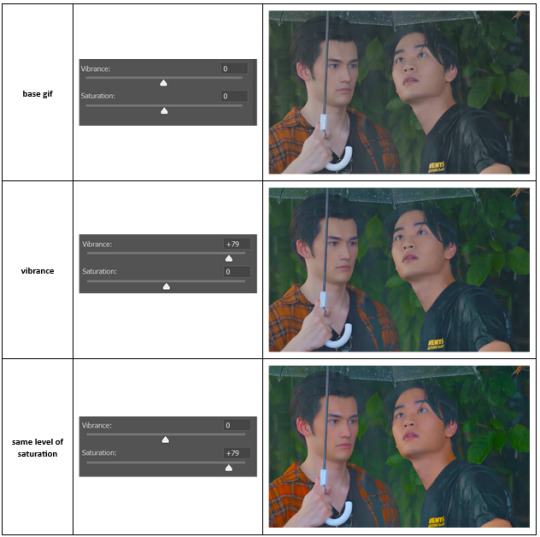
vibrance is much more subtle!
✨ colour balance
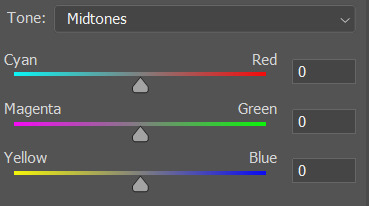
colour balance affects the overall balance of colours within a gif.
it's good for scenes with heavy tints.
I tend to stick to the 'midtones' dropdown, but you can also alter the colour balance within the shadows and highlights if you want.


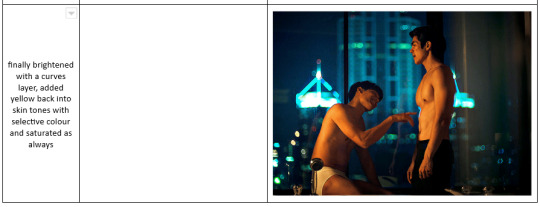
✨ channel mixer
I avoided channel mixer for such a long time because it scared me. but it's great for scenes that are very heavily tinted in one colour.
basically, it works with the levels of red, green, and blue within a gif. you select an output colour and then play around with the levels of the colour you selected within each other colour.
kind of the reverse of selective colour?
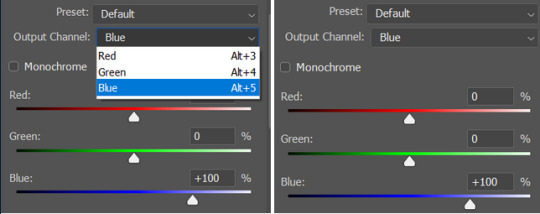
so in the 'blue' channel, the levels of blue are at 100%, and the levels of red and green are at 0% - but you can impact how much blue is in the reds and greens and blues.
this tutorial explains it well - but imo the best way to get to grips with channel mixer is just to play around with it a bit (sorry)
(when I made this guide for my friend, I also made a slightly more complicated gif colouring walk-through that included using channel mixer. there isn't space to include it within this post, but if anyone is interested I could always upload it as an 'intermediate' gif colouring tutorial - lmk!)
4. troubleshooting
‼️curves
usually with a bit of fucking about a curves layer works well - but sometimes you can’t find a good white and black point anywhere, and instead your gif turns wacky colours and nothing looks good. this happens more often with very heavily colour tinted scenes :(
for example, with this base gif:

using many of the brightest points as a white point turn it wacky colours, like this:

yikes :(
some options for these cases:
try brightening the gif first with the 'auto' button on the curves layer or with a levels layer. having a brighter gif to start with can give you better options for picking a white point.
try finding an alternate, whiter/brighter white point. look for places the light reflects - on this gif, using the light on Porsche's cheekbone works well as the white point. it also helps to find places that would be white if the scene wasn't tinted - the lightest part of a white shirt is often a good place to start, for example.
skip the curves layer, and instead use a levels layer to alter your white/black points, and colour balance or channel mixer to balance the colours.
‼️over/undersaturation
if your gif (especially the skintones) is looking a little washed out or lifeless, it might be undersaturated. boost that saturation - or if that's not working, try a vibrance layer.
oversaturation is often easiest to spot in the mouths and ears of any people in a gif. if the mouths are looking unnaturally, vibrantly red, then you've gone too far with the saturation.
5. fin!
and done! I hope this was coherent helpful to somebody.
if there's anything that I've missed or that doesn't make sense pls feel free to shoot me an ask or a message and I'll do my best to help! I've also collated a bunch of additional reading/resources below.
happy gifmaking 🥰
✨ some links!
photoshop basics by @selenapastel
gifmaking for beginners by @hayaosmiyazaki
gifmaking guide for beginners by @saw-x
dreamy's gif tutorial by @scoupsy-remade (includes instructions on how to blur out burned-on subtitles or annoying video graphics)
beginner's guide to channel mixer by @aubrey-plaza
how to fix orange-washed characters by aubrey-plaza
colour correcting and fixing dark scenes by @kylos
does resampling matter? by usergif
how to put multiple gifs on one canvas by @fictionalheroine
watermarking using actions by @wonwooridul
resource directory by @usergif
#i got a couple of asks about this so i figured i'd type it up as a post#it's been sitting in my drafts for a while now though i'm so sorry omg.#i had to replace my laptop and it took me a while to get round to downloading photoshop on the new one#but i hope this is helpful!!#gif making#tutorial#photoshop tutorial#colouring tutorial#coloring tutorial#gif colouring#gif coloring#photoshop resources#gif tutorial#gif resources#userbunn#uservik#darcey.txt#darcey.gif#usergif
444 notes
·
View notes
Text
Welcome
The response to the Comment Bingo has been amazing so far! Let's keep that momentum going. If you want to join, you can play with the original card or choose one of the other available cards:
one designed for Beginners (new or nervous commenters)
a Fluff Edition, Smut Edition and Angst Edition to find/comment on fics with themed tags
This blog is intended to promote anything and everything related to fic writing and commenting. In the fandom ecosystem, both creators and enjoyers are essential, but especially active creators and enjoyers—by which I also mean interactive.
For now, this is what I can guarantee from this blog:
more bingo cards for readers, featuring a mix of old and and new commenting tasks
bingo cards designed for writers (daily writing tasks; prompt tasks)
resources on commenting: etiquette and how-tos, etc.
celebrations of commenters who earn bingo (✨victory badges✨)
fic recs from bingo players who post the works used to fill their cards
OG Bingo Winners Board: Single, Double, Triple, Quadruple, Quintuple, ✨FULL CARD✨
Fluff Edition Winners Board: Triple, ✨FULL CARD✨
Depending on level of interest, this could also be a space to host more ambitious events (ship- or fandom-specific comment drives, comment drives for categories of fic with typically less traffic, etc).
Always open to feedback and suggestions! Here's the running FAQ post for the bingo trial.
The goal is to foster as much positive fandom engagement as possible 💛 Keep fandom well fed!
no pressure, just tagging anyone who expressed interest in the bingo trial run:
@sanguine-tenshi, @mrprettywhenhecries, @tciddaemina, @tapedsleeves, @unquantifiablefucks, @1jet2unknown, @doctor-of-war-and-heartache, @sterekbros, @evanesdust, @g-arya, @suometar, @camaro-and-smokes, @dragonflylady77, @redfeathered, @iravenish, @nibupei, @larkandcarry, @im-psycho-btw, @luimagines, @kallisto-k, @yallwildinrn, @adhd-merlin, @ah0yh0y, @neewtmas, @six-demon-bag, @silent-silver-slip, @magniloquent-raven, @garden-variety-jumo, @autistic-katara, @ghuleh-recs, @kissingghouls, @thissortofsorcery, @the-ravening, @toburnup, @gunshou, @daddiesdrarryy, @starryeyedjanai, @cattailhighway, @hexiewrites, @to-spread-the-ministry, @skystamp, @goddamnedamericanjedi, @likeapaperplane, @forgottenkanji, @minnichan, @asoftspotforangels, @lungache, @the-marron
#hit the limit on tagging people i think#so i'll reblog and tag more#sorry if that's obnoxious idk how else to direct attention here from the original post 😅#feed the fandom fest#comment bingo
317 notes
·
View notes
Text
How To Eliminate Passive Voice From Your Manuscript

Welcome to my guide on eliminating passive voice from your manuscript! If you're striving to enhance the clarity, strength, and engagement of your writing, mastering the art of active voice is essential. Passive voice, while sometimes sneaky, can dull the impact of your prose and weaken the connection between your readers and your story.
In this blog, we'll delve into the intricacies of passive voice, providing practical tips and strategies for identifying and transforming passive constructions into active ones. Whether you're a seasoned writer looking to refine your craft or a beginner eager to strengthen your prose, this guide will equip you with the tools and knowledge needed to banish passive voice from your writing once and for all. Let's dive in!
Understanding Passive Voice
Passive voice occurs when the subject of a sentence receives the action of the verb, rather than performing the action itself. This often results in a sentence structure where the subject is being acted upon, rather than actively engaging in the action. Identifying passive voice can be tricky at first, but with practice, you'll become adept at recognizing its telltale signs.
Here are some key characteristics of passive voice:
Use of the Verb "To Be": Passive constructions often feature a form of the verb "to be" (such as "is," "was," "were," "has been," etc.) followed by a past participle. For example, "The cake was baked by Sarah."
Missing or Unclear Subject: In passive constructions, the subject that is performing the action may be omitted or downplayed, leading to ambiguity or a lack of clarity about who or what is responsible for the action.
Focus on the Object of the Action: Passive voice tends to emphasize the object of the action rather than the entity performing the action, shifting the focus away from the doer and potentially weakening the impact of the sentence.
Wordy or Indirect Phrasing: Passive constructions often result in wordy or indirect phrasing, with unnecessary words or convoluted sentence structures that can obscure the intended meaning.
By familiarizing yourself with these characteristics, you'll be better equipped to spot instances of passive voice in your writing and take steps to address them effectively. In the next section, we'll explore why passive voice can be problematic and offer insights into its impact on your writing.
The Pitfalls of Passive Voice
While passive voice has its place in certain contexts, overreliance on it can lead to several drawbacks in your writing. Understanding these pitfalls is crucial for refining your prose and ensuring clarity and effectiveness in communication.
Here are some reasons why passive voice can be problematic:
Obscured Responsibility: Passive constructions can obscure who is performing the action, leading to ambiguity or confusion about responsibility. This lack of clarity can weaken the impact of your writing, especially in cases where accountability or agency is essential.
Wordiness and Indirectness: Passive voice often results in wordy or indirect phrasing, adding unnecessary complexity to sentences. This verbosity can detract from the clarity and conciseness of your writing, making it more challenging for readers to follow and understand your message.
Reduced Engagement: Passive constructions tend to be less engaging than active voice, as they place the emphasis on the recipient of the action rather than the doer. This can lead to a passive or detached tone in your writing, diminishing its impact on the reader.
Weakened Verbs: Passive voice often relies on forms of the verb "to be," such as "is," "was," or "has been," which are less dynamic and descriptive than active verbs. As a result, sentences in passive voice may lack the energy and vividness that active constructions can provide.
Loss of Clarity and Precision: Passive constructions can obscure the sequence of events or cause-effect relationships in a sentence, leading to a loss of clarity and precision. This can make it more challenging for readers to follow the flow of your ideas or understand the intended message.
By recognizing these pitfalls, you can take proactive steps to minimize the use of passive voice in your writing and enhance the clarity, engagement, and impact of your prose. Now that you’ve understood how to identify passive voice and why you should eliminate it, let’s delve into strategies for correcting passive voice in your manuscript.
Converting Passive Voice to Active Voice
Once you've identified passive constructions in your writing, the next step is to transform them into active voice for clearer and more engaging prose. Here are some practical strategies and tips for making this conversion:
Identify the Doer of the Action: In passive constructions, the doer of the action is often either implied or omitted. To convert passive voice to active voice, start by identifying the agent or subject responsible for the action. This might involve rephrasing the sentence to include the doer explicitly.
Reverse the Sentence Structure: Passive constructions typically feature a subject that receives the action followed by a form of "to be" and the past participle. To convert to active voice, reverse this structure so that the doer of the action becomes the subject, followed by the verb in the appropriate tense.
Choose Strong Verbs: Active voice tends to use strong, specific verbs that clearly convey the action being performed. When converting passive constructions, select dynamic verbs that vividly describe the action and imbue your writing with energy and momentum.
Focus on Clarity and Directness: Active voice often results in clearer, more direct communication by placing the doer of the action at the forefront of the sentence. Aim for sentences that convey the action efficiently and effectively, minimizing ambiguity and confusion.
Use the Active Voice Checklist: Consider using a checklist to systematically evaluate and revise passive constructions in your writing. This might involve asking questions like "Who is performing the action?" and "Is the sentence structured with the doer as the subject?"
Rephrase and Revise: Don't be afraid to experiment with different phrasings and sentence structures as you convert passive voice to active voice. Be willing to revise and refine your sentences until they achieve the clarity and impact you're aiming for.
Maintain Consistency: As you revise your writing for active voice, strive for consistency in your stylistic choices. While active voice is generally preferred for its clarity and directness, there may be occasions where passive voice is appropriate or necessary for emphasis or rhetorical effect.
By applying these strategies and techniques, you can effectively convert passive voice constructions to active voice, enhancing the clarity, engagement, and overall quality of your writing. In the following section, we'll explore common pitfalls to avoid and additional tips for mastering the art of active voice.
Passive Voice Example:
Passive Voice: The decision to implement new policies was made by the executive board.
Active Voice: The executive board made the decision to implement new policies.
In this example, the passive construction "was made by" has been revised to the active construction "made," placing the executive board (the doer of the action) at the beginning of the sentence and making the sentence more direct and engaging.
Common Pitfalls and Mistakes to Avoid
While you're working to eradicate passive voice from your manuscript, it's important to be mindful of common pitfalls and mistakes that can inadvertently lead you back into passive constructions. Here are some key things to watch out for:
Overcorrection: Sometimes, in the eagerness to eliminate passive voice, writers may end up with awkward or convoluted sentences that disrupt the flow of their writing. Remember that active voice should enhance clarity and readability, not detract from it. Strive for balance and naturalness in your prose.
Forced Active Voice: Be cautious of forcing every sentence into the active voice. While active voice is generally preferred for its directness and clarity, there are instances where passive voice is appropriate and even necessary. Don't sacrifice meaning or coherence just to avoid passive constructions.
Ignoring Context: Consider the context and purpose of each sentence before deciding whether to change passive voice to active. In some cases, passive voice may be the better choice for emphasizing the receiver of the action or maintaining a specific tone or perspective. Always prioritize clarity and effectiveness in communication.
Neglecting Variety: Strive for variety in sentence structure and voice throughout your writing. Overreliance on either passive or active voice can lead to monotony and dullness in your prose. Experiment with different constructions to keep your writing engaging and dynamic.
Failing to Edit: Finally, remember that eliminating passive voice is an ongoing process that requires careful editing and revision. Don't expect to catch every instance of passive voice in your initial draft. Take the time to review and revise your writing, seeking out passive constructions and replacing them with active alternatives where appropriate.
By being aware of these pitfalls and actively working to avoid them, you'll be better equipped to craft prose that is clear, engaging, and free of unnecessary passive voice.
Resources For Eliminating Passive Voice
When it comes to refining your writing and eliminating passive voice, there are several resources and tools available to assist you. Here are some helpful resources to consider:
Writing Guides and Style Manuals: Many writing guides and style manuals offer comprehensive advice on grammar, style, and sentence structure, including tips for recognizing and eliminating passive voice. Examples include "The Elements of Style" by Strunk and White and "The Chicago Manual of Style."
Online Writing Communities: Engaging with online writing communities can provide valuable feedback and support as you work to improve your writing skills. Websites like Reddit's r/writing and platforms like Wattpad and Scribophile offer forums where writers can share their work, receive critiques, and learn from others.
Writing Workshops and Courses: Participating in writing workshops or enrolling in writing courses can provide structured guidance and instruction on various aspects of writing, including passive voice elimination. Look for courses offered by reputable writing organizations or taught by experienced writers and instructors.
Writing Software: Many writing software programs, such as Grammarly and ProWritingAid, include features that can help identify and correct passive voice in your writing. These tools can be especially useful for catching passive constructions that you might overlook during the editing process.
Grammar and Style Guides Online: Numerous websites offer free resources and articles on grammar, style, and writing techniques. Websites like Purdue OWL (Online Writing Lab), Grammar Girl, and The Writing Center at the University of Wisconsin-Madison provide clear explanations and examples of passive voice usage and strategies for eliminating it.
Writing Blogs and Podcasts: Following writing blogs or listening to writing podcasts can expose you to valuable insights and advice from experienced writers and industry professionals. Look for blogs and podcasts that focus on craft, style, and revision techniques.
Books on Writing Craft: There are many books dedicated to the craft of writing that offer practical advice and exercises for improving your prose. Books like "On Writing Well" by William Zinsser and "Bird by Bird" by Anne Lamott contain valuable tips for honing your writing skills and eliminating passive voice.
By leveraging these resources and incorporating them into your writing practice, you can develop a deeper understanding of passive voice and cultivate the skills needed to eliminate it effectively.
I hope this blog on How To Eliminate Passive Voice From Your Manuscript will help you in your writing journey. Be sure to comment any tips of your own to help your fellow authors prosper, and follow my blog for new blog updates every Monday and Thursday.
Looking For More Writing Tips And Tricks?
Are you an author looking for writing tips and tricks to better your manuscript? Or do you want to learn about how to get a literary agent, get published and properly market your book? Consider checking out the rest of Haya’s book blog where I post writing and publishing tips for authors every Monday and Thursday! And don’t forget to head over to my TikTok and Instagram profiles @hayatheauthor to learn more about my WIP and writing journey!
#hayatheauthor#haya's book blog#haya blogs#writers on tumblr#writer community#writer tools#writer blog#writer stuff#writer tips#creative writing#writers of tumblr#writerscommunity#writeblr#writing community#writer things#writing tools#writing stuff#writing#writing life#writing inspo#writing help#writing advice#writing inspiration#writing ideas#writing things#writing tip#author advice#author resources#author tips
168 notes
·
View notes
Text
➳ 𝐂𝐨𝐫𝐯𝐢𝐝 𝐂𝐫𝐨𝐬𝐬𝐛𝐨𝐰 🪶🏹
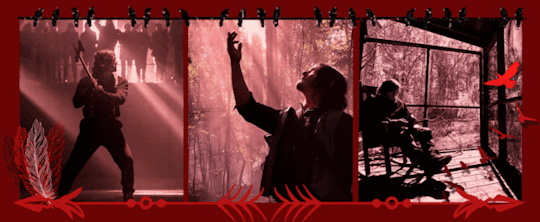
Hey y'all welcome to the absolute dumpsterfire of my brainrot (blog), you can call me Corvid or Harbinger
Ima lover of all things Norman Reedus, n obviously TWD + Daryl Dixon. I also really like crows, and Qrow Branwen from RWBY – hence my user
Below is my masterlist that I'll update w/ time, then more about me, idk I just gotta break the tumblr ice 🗿 I lurked on here for way too long
(Fair warning my ass does NOT know how to use tumblr I suck at this shit)
❥-》》—————➣
♡ = Sweet ♧ = Angsty ♤ = Smutty
❥-》》—————➣
𝐃𝐚𝐫𝐲𝐥 𝐃𝐢𝐱𝐨𝐧 ♡
➳ Drabbles:
Daryl w/ Hazey by GA ♧
Mother's Day ♡ ♤
Purring ♡ ♤
Hip Bones ♤
Lazy Morning Sex ♤
Daryl Likes Puzzles ♡ ♧
Falling Asleep in Sex ♡ ♤
➳ Short Stories:
I Like It Long ♤
Double The Fangs, Double The Fun ♤ (vamp + Scud)
Daddy's Little Dhampir ♡ ♧
Intruders ♡ ♤
Total Eclipse Of The Heart ♡
𝐉𝐨𝐬𝐡 "𝐒𝐜𝐮𝐝" 𝐅𝐫𝐨𝐦𝐞𝐲𝐞𝐫 ♡
➳ Drabbles:
Scud's a Nerd ♡
❥-》》—————➣
➳ I'm kinda a beginner writer (?), I've been doing creative writing for ages + fanfics for myself, this is just my first time posting n stuff
➳ I tend to write in the middle of the night too, n I mostly write reader dialogue the way I talk (which according to everyone I know I have an odd dialect), so if things in my fics ever don't make sense/ sound weird that's why 😭
➳ This'll center around Daryl/Norman because he lives in my psyche and I love him
➳ Ima chronic overuser of the 😭, 🙏, 🗿 and ‼️ emojis
➳ Most my works will be x fem!reader, but I try to keep physical descriptions more neutral & limit the use of y/n (cuz all Norm. chars. are nickname linguists). I'm also open to writing for anyone!
➳ Hardcore switch Daryl truther ‼️
➳ I will NOT write:
Abuse of any sort (unless it's something from the past/ apart of a trauma healing thing – essentially I won't write char. abusing reader, or vice versa)
Rape/SA (same as abuse, possibly if it's in past/ apart of something specific. I will not write char. raping or assulting reader, or vice versa)
Overly large age gaps, DDLG/MDLB, age play, weird innocence stuff, smut stuff with underage characters, etc.
Incest and mommy/daddy kinks that veer into incestuous behavior
Certain other kinks, fetishes n whatnot (If there's ever reqs for something I'm not comfortable writing, I'll mention so)
➳ But otherwise, I'd do most anything with that man and will hear you out – and I'm open to requests ‼️ (currently just for Daryl & Scud cuz they've fried my brain BAD)
➳ Feel free to send me inboxes about whatever other junk too! Like just chatty stuff
➳ (I also don't have any plans on writing char x char fics, partly cuz I don't wanna get into shipping wars as a veteran and survivor of the RWBY fanbase, but also it's just not my focus)
➳ Frankly I'd just love to engage with y'all on here, so many of you are so talented n I love your works 🫶
#masterlist#daryl dixon#daryldixon#norman reedus#normanreedus#twd#twd daryl#daryl dixon headcanon#daryl dixon imagine#daryl dixon x reader#the walking dead#daryl dixon x y/n#daryl dixon x you#daryl dixon x female reader#twd daryl dixon#daryl dixon smut#daryl dixon fanfiction#daryl dixon fanfic#norman reedus x reader#the walking dead fanfiction
69 notes
·
View notes
Text
Lift a Pen and Rewrite the Ending
Fluff for our broken fluffed-out hearts
Dedicated to @bunny584 because ow. I promised fluff, so I’m delivering fluff
Pairing: Satoru x piano teacher!fem!reader
CW: just some fluff, man. We all need some happy, sappy moments in our lives with our beloved dumbass boy.
You taught piano. Plain, simple, easy. At least, you thought so, before meeting an enigmatic man as your newest student. He played a little too well for a beginner, and seemed a little too familiar.
AN: I chose to post this on my side acc since this one was technically made for the exact purpose of writing JJK fics (same with the Ao3 acc (milk_bunny/chimeric-dreams for that one)). So, cheers to the first fic on this blog!
This was honestly scribbled down in a single sitting between 1-5 am. Please don’t judge any mistakes too harshly, I wanted to post it ASAP and not subject it to my endless course of corrections and re-writing.
This is also very short (lmao 6.7k words) for how my work is normally. Again, I just wanted to get it out as fast as I could ;w;
smol update: this has been (minorly) edited! nothing big, I mostly just went in and fixed up a couple mistakes + summoned my dearly beloved thesaurus. Otherwise, it's basically 98% the same as before!

Music sheets laid scattered around you, annotated in messy scribbles in various colors, fonts, and sizes. A scratched out row of bars here, corrected or adjusted notes there, mindless rambles stuffed into the margins as you tried desperately to figure out which key to put your song into so that it matched the exact tone you were going for.
Not like you were some well renowned artist whose career rode on their sole ability to create magical orchestrations. No, you had barely any presence at all. The videos of your songs you posted on YouTube hardly scratched a couple hundred viewers at most, with the occasional comment from a bot or scammer getting your hopes up, only for them to go crashing back down.
You weren’t some notable figure in the music industry, you were just a white-collar worker that taught piano from your tiny home part-time.
It suited you, you supposed, as bitter as you could feel at times. You were just a normie, a casual passerby who liked having your fingers spring and jump across the keys of your instrument. It was one you inherited from your grandmother. She was the one that taught you how to play when you were little, while your parents were busy working and couldn’t sit and entertain you all day like she could.
She taught you some essentials, too, like how to tune the spinet – ‘It’ll save you big bucks, bunny,’ she insisted – and how to detect even the slightest issue it might have. She was correct about it saving you big bucks.
As shabby as the thing looked, with peeling white paint and floral designs chipping off the sides, the cover scraped to hell and back, and the brassy pedals having long lost their glossy sheen, it was in perfect shape.
In your expert opinion, anyway. You were biased, so what? You had every right to be.
Granny had left the world a while ago, her ashes situated on the short mantel of your tiny fireplace. You lit the candles every day, rested two softly smoking incense sticks on the shallow bowl to catch their cinders, and gave her a swift good-morning before you raced out your door, inevitably arriving at work with only minutes to spare.
In the evenings, you’d teach, then ramble to her about your day, wish her a loving goodnight, and go pass the fuck out. Rinse and repeat, except weekends, where you were teaching all day.
It was tiring, working two jobs like this, especially when some of the kids you taught were insufferable, but music was your passion. At the end of the day, you viewed it as worth every minute spent doing something you loved.
You liked to think she would have been proud of you.
A light tapping sound, a knuckle rapping against the wood of your open front door, caught your attention. It was a warm day, one that was too good to spend with the doors and windows closed. Natural light flooded in, casting the figure standing at the entrance in a brilliant glow that hid their features from you.
You glanced at the clock on the wall to your left, then leapt up from the floor in front of your coffee table, hurriedly and messily stuffing your music sheets into a folder. “Oh, shoot, sorry! I didn’t see the time, I’m so sorry about that. Are you the two o’clock?”
Today was a surprisingly free day for you. You only had one appointment, with a new student, if you remembered correctly. You must have gotten so ingrained in your rapid-fire notations that you lost track of time.
While you weren’t expecting an adult, since the email sounded like it was from a teenager, it wasn’t uncommon. You had students of all varying ages, anyways. It was a nice change, too; you found that adults tended to listen better than children.
A smooth laugh greeted your ears, the sound impossibly pleasant to your ears. “It’s fine,” the man said as he stepped into your home, breaking from the prison of light holding him. His stark-white hair caught you off guard first, followed by his height, and then the round shades resting low on the bridge of his nose. “That’s me.”
Eyes as blue as the most vivid summer sky peered straight through yours and into your soul, his hues almost appearing to shine in the tranquil environment of your living room, without the help of the overhead lamp you had turned off. His lips curled into a sparkling grin, giving him this sort of youthful luminance that had your heart skipping beats.
You swallowed and looked away before his gleaming smile blinded you, striding over to your upright eighty-eight, using it as an excuse to busy yourself and avoid eye contact with him before he made you stop breathing just by fluttering his lashes.
“Come on in,” you responded stiffly, clearing your throat to ease off the tenseness in your muscles. Why were you getting so worked up over him? Sure, he was pretty, but you’d barely spoken two sentences to him. How had he managed to get you in such a tizzy so easily, where your tongue felt tied and your pulse raced in your wrists? “How much do you know about piano?”
“Uhh,” he set down his briefcase against the wall beside your door, slipped off his shoes, and met you next to the instrument. “I know a bit.”
“Alright,” you nodded and patted the bench, then paused to think if it would be too low for him. What intensely long legs. “Do you need me to get a different stool?”
He shook his head, sliding into the seat like it was second nature to him. “Nope, this is just fine.”
“Great,” you smiled at him and tucked your skirt under your hands as you sat down on the other end. “Let’s get started, then! Are you familiar with the different notes?”
His hands took place over the ivories and he slowly pressed each one down as he labeled them. “C, D, E, F, G, A, B, C.”
“Excellent, that’s awesome! You’re already a few steps ahead of other beginners,” you nodded approvingly and retrieved the thin booklet you had laid on top of the upper panel. You opened it and sifted through a few of the jingle options, picking out something a bit more intermediate for him.
It was still simple, but definitely more advanced than nursery rhymes. You found teens and adults had a more enjoyable time learning when they didn’t feel like they were being patronized. Teens especially, fickle little creatures, those ones.
“Let’s start with this one, then,” you said as you set it against the music rack in front of him. “It’s pretty easy, I think you’ll pick it up quickly.”
The piece consisted of quarter-note half steps that ignored the sharp and flat keys for now. You had placed a piece of tape over the tempo indicator, finding that it put your students under too much pressure and made them stumble in their rush to follow the pacing they thought was right when they didn’t know what tempo was to begin with.
The man took a few seconds to study the sheet, then placed his fingers on the corresponding keys and began playing.
He was a bit slow, holding some notes too long and others not long enough, but you were correct in thinking he’d get the hang of it fast. After a few runs, he was playing it decently well, and confidently, too.
“Perfect! I knew you’d get it like that,” you snapped your fingers, then picked up the booklet again, flipping the pages in search of something a little more challenging. You probably wouldn’t find it in a kiddie book like this one, so you placed it down and got up, grabbing a more advanced one from the side table nearby. “What got you wanting to learn how to play?”
“Ah,” he scratched the back of his head. “My dad always wanted me to learn as a kid. I finally caved in, if only to make him stop yapping in my ear during family dinners. I’m just twenty years late to the party.”
You burst into giggles as you returned to your place on the bench, placing the new song you had chosen out for him where the previous one had been. “Not the first time I’ve heard that. You’d be surprised how many later bloomers there are.”
He chuckled along with you. “Well, that’s a relief. Had me fearing I was the only fully grown student you’d see in your life.”
“Far from it,” you shook your head. “I teach a grandfather that wants to play for his grandson at his graduation next year. It’s never too late to learn.”
When you looked up at him, you found him already peering at you with those intensely cerulean irises, his sunglasses folded neatly into the collar of his shirt. You twitched, startled by his stare. He had you locked in his gaze, captivated as he observed you and you observed him.
You noticed with wonder and fascination that his lashes were as milky white as the tresses on his head.
He really was beautiful. Those same lashes were long and soft, brushing his high cheeks whenever he blinked. His lips were plush and pink, seemingly always curled up into a permanent smile regardless of size. Life and boyish playfulness darted in those mesmerizing oases that refused to shake their hold on you, and you wouldn’t wish them to.
They were the breath of fresh air you never knew you were deprived of, the nectar of life that was water to your parched throat, the flickering mirage that came to life before your very being.
You felt drawn to him, inexplicably. There was something so… familiar about him, though you couldn’t pinpoint exactly what. Like you’d seen him before, across the metro platform, or walking into the store you were just leaving, or someone walking the opposite direction as you on the crosswalk.
Where have I seen you before?
You blinked yourself out of the illusion, your lips parting, closing, then parting again before you finally managed to find your voice. “I-I’m sorry. I forgot your name, could…could you remind me?”
“Ah,” he shook his head, forgiving your forgetfulness. “Just call me Satoru.”
Just Satoru? Is that really okay?
It doesn’t sound like a name I’ve heard before.
“Alright,” you agreed regardless. “Satoru it is. It’s a pleasure to meet you,” you murmured your own name in return, dipping your head down in a mini bow. You returned your attention to the music sheet, lightly tapping the back of his hand with your pointer finger. “Let’s continue, shall we?”
You noted how much bigger his hands were compared to yours. It was hard not to see it, your index finger would likely barely reach the topmost joint of his if you pressed your palms together.
Your hands tingled at the thought. You quickly shoved it aside, focusing on being a good instructor.
Satoru continued to surprise and impress you as he mastered the tunes you chose for him after trying them out a few times. Each time he made a mistake, he listened attentively as you corrected it, laying your hands over his as you adjusted the positioning of his fingers.
“Your hands are so much bigger than mine,” you snickered. “I’m a bit jealous. It’s hard for me to reach those far keys sometimes.”
“Oh, yeah,” he grinned cockily, flashing you a sultry glance between chords. “They can reach a lot of things very easily.”
Heat rose to your cheeks and you stuttered, whipping your head away and acting as if he hadn’t completely flustered you.
Truthfully, the session was only supposed to last an hour and a half, but when you looked up at the clock, you were shocked to see you were nearing an hour longer than expected. It didn’t feel like much time had passed at all, maybe thirty minutes at maximum. Had it really been that long?
You pushed yourself up, stretching your legs as you felt pins and needles spark up in them. “Seems I got distracted twice today. I’ve kept you for an hour longer than I intended, I’m sorry,” you laughed meekly. “Don’t worry, I won’t charge extra for that, that’s on me.”
“It’s no worry,” Satoru reassured you as he got to his feet as well, delicately closing the fallboard with a careful hand. “Are you sure, though? I don’t mind paying for it, I did take up your time.”
He made something warm form in your chest.
“It’s fine, I love teaching. It’s not my main job, anyway, don’t stress,” you brushed away his concern. “You’re a prodigy, y’know,” you told him as you walked him to the still open door. “It’s no wonder your dad wanted you to learn how to play. I’m sure he’s proud.”
He let out a chuckle that sounded maybe a little forced. “Yeah, hope so,” he responded as he eased his shoes back on and bent down to grab his briefcase. “You’re a great teacher.”
“Thank you,” you brushed your hair behind your ear, blushing. “Ah– when would you want to see me again? I-If you do, I mean.”
The odd firmness he had a moment ago melted away, once more replaced by that handsome smirk of his. “Same time next week? Ah, hang on, why don’t I get your number, just in case? I have a bit of an unpredictable schedule.”
“Oh, sure, no problem,” you assented, taking his phone after he unlocked it and passed it to you. “You don’t like using email?”
He shook his head, watching you punch in your number into a new contact, add your name, then hand it back. “Nah, texting is easier for me. I’ll message you later tonight, yeah?”
“Alright,” you acquiesced.
“Oh, right, how much do I owe you?”
You blinked a few times before recalling that it was technically a paid session, though it didn’t feel like that to you. You murmured out the cost, and he gave you an odd look for a brief second. He pulled out his wallet, counted out a few bills, and folded them in half neatly before passing them off to you.
“Thanks for the lesson,” he grinned and waved goodbye, promising to text you later as he headed down your walkway, turned the corner, and vanished from sight.
You closed the door with a quiet poompf, staring blankly at your piano as you tried to remember how to function again. You glanced down at the bundle of money in your hand when you thought it felt a little too thick, brow furrowing as you unfolded it and counted and holy shit that’s way too fucking much–
You rushed out of your house, down the pathway to the sidewalk, and looked for him, though you knew it was futile. He was already gone.
You tried to think of how you were going to slip the excess money back into his pocket next time you saw him, but as soon as you were inside, you raced to the folder you left on your coffee table, practically ripping it apart as you pulled out all the papers, aggressively uncapped a pen, and got to writing at light speed.
That man, whoever he was, infected you with a painful shot of inspiration that you needed to get off your chest right then and there. Your hand flew across the pages, revising entire sections you had been stuck on for weeks in the blink of an eye. Messy verses were refined, the missing notes floated into place, and by the time the moon had risen high and the timid breeze had turned cold, you had finished your song.
You looked it over one last time, a disbelieving giggle escaping you. You finished it. You finished it. This damned piece had been giving you restless nights, a broken loop in your brain that kept skipping over the unwritten parts, but one session with Satoru had seemingly given you the one push you were missing all along.
Your phone buzzed.
You opened it and tapped on the messages icon to find a text from an unknown number.
Unknown, 9:17 PM
Hey! Sorry for texting so late. It’s Satoru.
Does next week still work for you, same time?
What divine timing on his end. Right as he entered your thoughts, he slid into your DMs.
Your fingers practically trembled with giddy excitement as you texted back instantly to confirm the time, uncaring of what kind of impression that was making on him. You were elated, feeling like you could exhale in peace at last. You gave a little victory cheer as you went about closing and locking all the windows and doors, pulling the curtains shut with so much energy, you questioned if you’d be able to sleep.
The answer was yes. After you had gotten all ready, having pampered yourself as a small reward for yourself, you fell onto your bed and passed out mere minutes later. For once, everything seemed to be going right.
─────•(-•ʚɞ•-)•─────
“How’d you learn how to play?” He asked one day as he sipped at the tea you prepared for him. He was right about his schedule being hectic at times, but he somehow managed to fit himself into having lessons with you a few times a week, rather than just the standard one.
It surprised you, but pleasantly so. He was eager to learn and improve, and you were more than happy to teach him. He made for fantastic company, too, and you found you enjoyed spending time chatting lazily with him just as much as you did instructing him.
“My grandma taught me,” you told him with a smile. “She passed away a while ago, but I like to think I’m keeping her legacy alive like this, by teaching others, and keeping that old lil’ thing alive.”
Satoru nodded in understanding. “You’re amazing at playing,” he complimented sweetly. “She did a great job.”
“Thank you,” you answered bashfully, hiding your blush behind your own mug of tea.
“What was she like, if you don’t mind me asking?”
His smile felt like the sun kissing the apples of your cheeks on a perfect spring day. Him wanting to know more about you had your heartbeat picking up in speed, chirping a new, happy melody like a canary.
You deliberated before replying. “She was a very shrewd woman, stern in her teaching, but very gentle at the same time. She was the kind of granny that snuck me pieces of candy when my parents weren’t looking. She let me stay up late playing music whenever I was staying at her place. I probably bugged my parents to let me stay there every weekend, just so I could play it and learn from her.”
“So you got into music young?”
You bobbed your head. “I fell in love the first time I heard her playing when I was a toddler. I had woken up from a nap one day, somehow escaped my crib, and crawled to the living room to watch her play for…man, I don’t even know how long. I was just…hypnotized.”
“She sounds like she was a maestro,” he snickered airily, though you knew he meant it.
You grinned widely, resting your chin on the curved cup of your palm. “She really was. I can show you some videos of her playing sometime, if you’d like to see,” you offered.
“I’d love to.”
─────•(-•ʚɞ•-)•─────
Satoru had been your student for a while now.
He zoomed through the intermediate pieces into the advanced-amateur category easily, though seemed to plateau around there. Despite this, he was a wonderful student, always trying to improve himself and his skill. You knew he had it in him, he was only missing a little something he needed to tip him to the next level.
At one point, you had joked that he must have been purposefully holding himself back just so he could keep studying under you.
He laughed, and said nothing more.
By now, he reached a point where he would come in with a pep in his step, claiming he had perfected a lullaby he wanted to play for you before you started the session. You’d find yourself (politely) seated on your couch nearby, and would watch with a fond expression you didn’t know was there as he treated your piano with a touch more tender than even your own.
And you’d listen. He’d choose some of the prettiest, albeit not complicated, arrangements to play for you, and you’d find yourself slipping into a state of blissful peace. All your thoughts would drift away, and you’d absorb yourself in the music he played.
A few sessions had been spent just like that, with him as your personal musician, and you couldn’t figure out why you felt so…happy.
You liked the emotion a lot, though, and found yourself looking forward to his every visit, anticipating the full body chills you’d get whenever he lulled you into that state of delighted serenity. You didn’t remember when you stopped charging him, and when you let him come in without knocking anymore.
You also didn’t remember when having tea after each session became tradition, but you were grateful for the joy he brought you with his presence alone.
In fact, you decided to get him a small gift as thanks. For what exactly? His company? Patience? Entertainment? Whatever it was didn’t matter. It wasn’t anything big, either. It was a record you stumbled across while visiting a thrift shop recently.
You picked it up for two reasons. First, he divulged he had a hobby of collecting old vinyls. Second, he mentioned he had been searching for that specific record for a few years with no luck, saying it was the last one he needed to complete his collection from that particular brand. The moment you spotted it, you grabbed it and practically bolted to the cashier, uncaring of the price.
There was no way you were leaving it there for someone else to nab it before he could. It was the most reasonable option.
Which was why you were extra giddy to see him again.
You opened the door in the middle of him reaching for the handle, stunning him for a second. That bewilderment was quickly wiped away by an excited grin that surely matched your own.
“If I knew you’d be this enthusiastic to see me, I would have worn something better,” he quipped.
You snorted and waved your hand, stepping back so he could come in. “Am I not allowed to be happy to see my favorite student? You look good no matter what you’re wearing, anyway.”
“Favorite, eh?” He teased as he closed the door behind him, leaning down to give you a quick hug. “Now I really feel like I should have worn something fancy.”
“Oh, come on, it’s not that big of a deal,” you giggled, leading him to the usual spot.
“I dunno,” he hummed, a sly expression crossing his face. “Pretty big deal to hear that from my favorite teacher,” You rolled your eyes, smacking his chest weakly, to which he laughed openly. “Ready to get started, teach?”
What a gorgeous sound his laughter was.
“Actually,” you said, “I got something for you. Wait here a moment, lemme go grab it.”
He raised a brow but didn’t raise any objections as he sat down and tugged his tie to loosen it a few inches, saying that he’d be right there.
You had to resist the urge to skip to your room to locate the record and retrieve it from the drawer you had safely stored it in. It was your sock drawer, actually. You wanted to keep it somewhere protected while it tarried for its new owner. You sang the melody of your newest single quietly as you picked it up, inspecting the album cover for any indication that it had been touched since you last put it in there.
Pristine. Obviously aged, but in flawless condition otherwise.
Sounds from your living room brought pause to your actions right as you closed the drawer after dumping all your socks back into it.
…Was that music?
Frowning, you picked up the record and crept towards the source of the noise. You recognized it instantly – it was the most notable piece written by the notorious Gojo Saichi. It was considered the most difficult composition created within the last century or so. You’d listened to it on repeat occasionally, attempted it dozens of times, though you always fell short before the second movement started, which came early on.
Was Satoru watching a video? No, the melody was too clear and full to sound like it was coming out of a phone speaker.
Then…
You froze in the entrance to the hallway, stuck in place as you watched Satoru play the oeuvre flawlessly. From where you were standing, at an angle, you could see his precise actions and motions. Every note came to him as naturally as air, each shift in tempo as easy as blinking, down to the fragile, silk-like contrast that made the instrument sound as if it was a weeping widow, sitting on a window sill as she descanted to the moon, alone.
His digits knew exactly where to go, when, how deeply to press, how to shift between fierce and floaty as if he was born to do exactly this.
As your eyes flickered from his hands to his face, you saw that his eyes were closed. He was doing what some musicians could only ever dream of achieving in their careers; he was uniting with the music, playing as one, letting it fill his heart, then pour out with every throb like the very blood in his veins.
The most complicated, difficult, astronomical concerto known to man in the modern age, and he was playing it like it was nothing.
Satoru must have sensed your burning gaping as his hues flickered open and his hands stilled over the claviature. He looked over towards you, his mien morphing into something resembling embarrassment.
You staggered closer. “That…that’s…that piece was…written by Gojo Saichi…” You mumbled, barely able to get the words out. You set down the record onto the coffee table, already having forgotten about it.
You were flabbergasted, rattled as you came to a stop at the side of the piano. He…how could he have played that so well? Wasn’t he barely in the advanced category? That was…that was professional, grade A, genius level music he played.
“Yeah,” he grinned, and you would have believed his show of being sheepish if the gleam in his eyes didn’t give him away. “He’s my dad.”
You sluggishly dropped onto your spot on the bench, peering at the keys but seeing nothing as you unpacked the bombardment of information you witnessed.
“That’s…the– that’s the hardest piece…even I can’t…”
“I know,” he rubbed his nape. “He basically forced me to stay up day and night playing it until I got it right.”
“But…how?” You tilted your head, peering up at him from the corner of your eye.
Satoru shrugged like he hadn’t just dropped a fucking bombshell on you. “I asked him to teach me when I was a teen,” You heard him say. “I’m sorry for deceiving you,” he apologized, not sounding very sorry at all.
“I…” You labored to find the right words. “Why didn’t you tell me?”
“Honestly?” He asked. You nodded, and he let out a heavy sigh.
Instead of answering immediately, he stood up and pulled you to your feet as well, pulling you into the kitchen, where he filled your kettle with water and put it to heat up.
You desperately wanted to know what exactly was going on, but couldn’t find it in yourself to rush him. He went about methodically picking out both your mugs from your cupboard, tossing a bag of tea into both, grabbing the bowl of sugar on the counter, and setting it all down on the table while he waited for the kettle to whistle. He seemed lost in thought, while you had many and none at all at the same time.
You could only observe him as he picked his words carefully.
He finally began when the shrill noise of boiling water filled the room. “I don’t know if you remember – probably not, since you didn’t recognize me – but we actually did meet a while ago. I was a lot different back then,” he said as he poured the water into both mugs, afterwards placing it back on the stove and holding his hand sideways at roughly chest level. “Maybe this high, scrawny, kind of a douchebag,” he admitted with a chuckle.
You were still in shock over the whole situation. All you could do was silently urge him to continue by leaning closer, accepting the cup when he passed it to you. Heat spread through your fingertips, easing away the frosty feeling you didn’t notice set in.
“You were playing the piano in the music room at the school we went to together. It was…honestly, beautiful. I grew up with a famous pianist for a dad, but even he can’t make music sound as alluring and gentle as you can,” he continued, awkwardly holding his own mug. “So, when I saw you again a few months ago, I couldn’t believe it was you. I always wanted to ask you to play something for me when we were younger, but could never get the nerve to.”
As he spoke, the memories were beginning to filter in through the thick haze in your brain.
You were so focused on writing music and learning to be a great musician like your grandmother that you never really paid attention to your surroundings or the people around you if they weren’t your granny, parents, direct friends, or music teacher.
From what you did remember, Satoru was always a confident, cocky boy, shameless and loud. To hear he was…shy about asking you to play for him was hard to believe.
“So, I finally let my dad start teaching me,” he rambled on when you didn’t respond. “I’ve tried so many times to replicate the song you played, but I could never get it right. I know it’s probably a long shot, but you don’t happen to remember what song that was, do you?”
You thought back, scraping the dust off your highschool recollections. There was one piece you had hyperfocused on perfecting during the last year there, determined to play it exactly as your grandmother had.
You never did manage to master it.
You set down the tea you had only sipped at twice and walked past him into the living room, heading to your piano in a sort of trance. You slid onto the bench, and set your fingers on the keys. Muscle memory took over, the gentle tune coming to life in…how long had it been since you last played this?
You let the music flow through you, gave it access to your heart, allowed it to peer into the deepest parts of your soul, and simply followed the path it created.
“Was it this one?” You asked quietly.
When you looked up at him, his eyes were wide, lips parted as he stared at you with nothing less than amazement. “That– that’s the one. Which– what’s it called?”
“It’s a piece my grandma wrote for my parent’s wedding,” you answered. “She didn’t tell me what it’s called. I’m not sure if it has a name to begin with. She played it for me once, and I,” you huffed out a short, choked chuckle, “I became obsessed. I spent every day as a senior trying to get it right, to play it like she did, but…”
Your fingers slowed into a stop as you looked at them blankly, recalling your attempts, and the disappointment that followed each failure. You memorized it after playing it just twice, but it didn’t help you reach your goal in the end.
You startled when his hand rested lightly atop of yours, his body partially leaned over your shoulder so he could look you directly in the eye. This close, you felt his light breaths as they brushed your cheek. You could see the exact shade and hue of the teal composing his striking irises, match the exact pace of his heartbeat to a sonata, hear him swallow nervously.
“Keep playing,” he rasped, sounding almost desperate. “Please.”
You obliged. How could you say no to him when he looked at you like that? When he requested it so feebly in a trembling voice that was close to cracking? How could you say no when you saw and felt firsthand how his body relaxed when you filled the room with the lilting melody once again?
The music hopped and glided, playful in some parts, somber and tranquil in others. He stayed right where he was, the heat of his stomach resting against your upper back, thawing the tension in your shoulders as his hands held them gently, thumbs rubbing circles into your tight trapezius.
In every way, the ballad reminded you of your grandma, of your parents, of your childhood spent trying to reach a point where you were truly happy with how you played each note.
But, if that was the case…
How come you saw Satoru’s eyes when you closed yours and listened to your own hands dance across the keys?
Why did his smile, his laugh, his touch, his voice, his everything, come to mind when you picked apart every stanza and bar? If you put together all the notes a specific way and decoded them, you swore they’d spell his name.
Your hands drifted and halted as you reached the end of the lilt.
Or, rather, the end as you knew it.
There was a brief pause, then he mumbled, barely above a hum, “is that it?”
“Grandma never showed me how it ended,” you told him morosely. “She said she’d tell me ‘when the time is right’, but…she died before she could.”
He sat beside you and took your right hand into his. His fingers massaged meaningless shapes into the creases of your palm and the smooth plane of the dorsum. Neither of you dared break the silence, mulling in your own worlds.
Satoru was the one to cautiously cross the line of quiet, doing his best to not disturb it. He wrapped his left arm around your back, pulling you into his side while continuing to toy with your dainty digits.
“We’ll find it together,” he whispered.
─────•(-•ʚɞ•-)•─────
Truth be told, you never imagined you’d find yourself in this kind of place before – especially not in this position.
Your hand hovered over your brow, shading your eyes from the brilliant sun as it shined low in the sky, kissing the horizon. Though it was setting, the approaching night was warm as ever. A pleasant breeze ruffled the fabric of your dress and caught the strands of your hair that managed to slip loose from the style your mother put them in.
Stars were already beginning to dot the expanse above, glittering and so, so crystalline when you were this far outside the city. You never thought you’d get to see them so clearly, enough to point out individual constellations, and even identify Jupiter and Venus.
You never had a reason to leave the bounds of the city before, so all this was a distant dream you might have had once when you were a teenager.
But here you were, outside a lovely villa, surrounded by friends, family, and loved ones, miles away from where light pollution would dare to touch. The buzzing, lively chatter of dozens of guests filled the air; the clinks of glasses, the clacks of forks and knives on plates, all of it was so animated. You felt like you were in a sort of daze, overwhelmed with happiness to the point that it almost didn’t feel real.
A pair of soft lips pressed against your temple, drawing your attention to radiant, minty-ocean hues.
Satoru gazed at you with nothing short of pure, raw, true adoration. Like every fiber in his body, each and every singular cell, was dedicated to loving you.
“I have one more present left for you,” he murmured against your lips, giving you a chaste kiss right after before he stood up and raised his glass. He tapped the back of his knife gently on the side, creating a chiming noise that settled the ongoing conversations with ease.
Once all the attention was on him, he set both objects down and began speaking.
“I know we’ve already said it a lot, but I wanted to thank you all again for coming here to celebrate this day with us,” he said, turning his gaze to you. “This is truly the happiest day of my life – so far,” he added cheekily, earning him a laugh from the crowd. “So, before all the festivities end tonight, I wanted to do one last thing, if you’d all be so kind as to grant me this moment.”
Of course they would. Satoru was just that type of person. Charisma poured off him in waterfalls, charming anyone he spoke to without effort – you included.
He pushed back his chair, moving to leave. Confused, you grasped his arm and called his name.
There was a glint of something in his eyes, something you couldn’t identify, not with the light tingle of wine sitting in the back of your mind and the overstimulation of the grand day.
“Just listen, baby,” he whispered to you, then he was weaving through the guests, snaking his way to the grand piano situated off to the side of where everyone was situated. “This is a little song I heard many, many years ago, and fell in love with from the first few notes. I’d like to dedicate it to my mother-in-law, father-in-law, their late mother, and I would like to especially dedicate it to my lovely wife.”
Your mother gasped, grabbing your arm as soon as Satoru began playing the familiar melody of the diapason you had been taught ages in the past. It was the one your grandmother played for you, just once. It was the one she played for your mother and father for their wedding. It was the one you played for Satoru, once unknowingly, and every time after that intentionally.
The one he was playing for you now.
Your mother teared up faster than you did, reaching for a clean napkin to dab her eyes with while she waved her free hand at her face, trying to stave off the tears so that they didn’t smear her mascara, though she wasn’t succeeding. Your father was gently shushing her, rubbing her shoulder while he looked between you and Satoru with pride, and you…
You recalled the first time you heard him play the composition his father had written, when you still believed he was just an advanced player. Back then, you felt entranced.
Now, you felt completely spellbound.
You lifted yourself, carefully making your way between the enchanted spectators. Some clutched and squeezed your hand as you passed, and a few others breathed out little congratulations to you, not risking breaking the delicate atmosphere.
By the time you made it to him, your vision was blurry, and he was playing the last line of bars.
The arrangement floated into the placid, halcyon evening, each individual note rising like a star to join the thousands that looked on with bated breath, protecting this little moment of clement apotheosis.
His hands swept across the final few steps, barely touching the keys at all. The concluding tone resounded, fragile and silk-like, followed by a second of calm silence before the crowd erupted with cheers, hoots, and deafening applause.
Satoru rose from the bench, encircling your waist with his arms and pulling you in for a deep kiss. It echoed in you, the sweetest lullaby, the happiest composition that could never be written down identically. It was one only the two of you could hear and feel, one only the two of you could dance, live, cry, laugh, breathe, and love to.
Of all the endings you ever tried to give that precious lullaby your grandmother had written so long ago, the one Satoru created was perfect.
Because you created it together.
─────•(-•ʚɞ•-)•─────
banner by cafekitsune ♥
#jujutsu kaisen x you#jujutsu kaisen x reader#jjk x reader#jjk x you#gojo x reader#satoru x reader#fem reader#I'm going light on the tags fn#is this considered light lmao#fluff#jjk fluff
140 notes
·
View notes
Note
Hi! I love your blog. Thank you so much for taking the time to share your tips and advice! 🥰 I want to change my persona into a more bold and passionate lady instead of they shy timid girl. Do you have any recommendations on resources that I can start with? I would also love to learn how to flirt seductively to attract men but also to flirt with friends just for fun. Can you pls point me to the right direction? Thank you so much!! ❤️💓💗
Hi love! Thank you so much for your kind words and support. These words mean a lot to me <3
Yes, gladly. Sharing some resources below:
How To Validate Yourself & Stop People Pleasing
How To Master Your Shadow Self & Embrace Your Dark Feminine Energy (Advice)
How To Reduce Social Anxiety To Boost Your Confidence, Make Friends, & Become Magnetic
How To Master Public Speaking Anxiety & Communicate Like A Boss
How To Master The Written Word & Communicate Like A Queen
How Flirt With Men, Hold Your Own, & Embrace The Art of Seduction
How To Rediscover Yourself, Set Boundaries, & Master Interpersonal Conflict
How To Build Unshakeable Self-Confidence
Ways To Appear More Mature & Embrace Your Sensual Side
How To Handle Rude People & Insulting Comments With Class
Questions To Ask When Evaluating Your Relationships
A Beginner's Guide To Embracing Your Sexuality
Simple Tips & Tricks To Seduce A Prospective Lover
How To Build Steamy Sexual Tension With Any (Potential) Lover
Femme Fatale Booklist: Decentering Men, Feminist Dating, & Childfree Living
Essential Feminist Texts Booklist
Empowering Affirmations To Unleash Your Dark Feminine Energy
Hope these help xx
#self concept#self confidence#personal branding#cult of personality#femme fatale#dark feminine energy#dark femininity#seductive women#art of seduction#it girl#dream girl#flirting#flirting tips#seduction#sexuality#female power#female excellence#female sexuality#female liberation#libido#self discovery#girl advice#girl blogging#glow up era#femmefatalevibe#feminist#feminism#female socialization#feminine power
190 notes
·
View notes
Text
Are you ready to start your own blog in 2023? In this 40-second video, we'll walk you through the essential steps for launching a successful blog.
From choosing a blogging platform and designing your site, to creating engaging content and monetizing your blog, we've got you covered. Whether you're a beginner or an experienced blogger, this video will give you the tools and tips you need to get your blog up and running in no time.
So if you're ready to turn your passion into a thriving online presence, watch this video now and start your blog journey today!
#blogging tips#blogging for beginners#blogging tips for beginners#blog#blog launch#blog tips#blogging 101#how to start a blog#blogging advice#blogging tutorial#blogging tutorial for beginners 2023#blogging tutorial for beginners#blogging tutorials for beginners 2022#launching a successful blog#blog in 2023#essential steps#successful blog#blogging community#blog sucess#blog branding#hosting services#blogging goals#blogging career#blogging resources
0 notes
Text
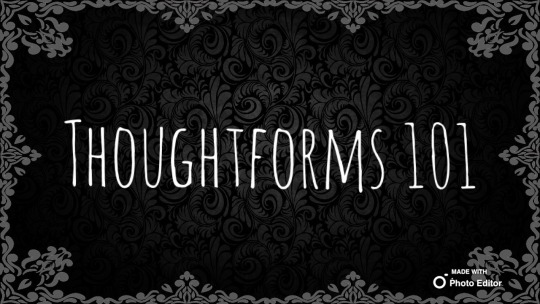

This is a topic that can get very confusing for those starting out. There are lots of interchanging terminology, beliefs, and constructs that not everyone sees fit to agree on. This can often create misunderstandings and propagate the misuse of certian energies making navigation for newcomers more than just problematic. In this blog, I will attempt to systematize some of the complexities enough to deliver a more organized path for beginners to follow and build upon.
Keep in mind, however, that while there are some definite rules to thoughtforms there is also a well of UPG around this topic. The knowledge surrounding thoughtforms changes quite considerably with the beliefs of the individuals that practice it. So take from this blog what you will.

The Basics
So I bet some of you are asking, what exactly is a thoughtform? Well, that’s a being created from our beliefs and thoughts. They are made up of energy and can be utilized in magickal workings. Now there is some confusion among some members of the community here. Sometimes the term is not seen as the umbrella term it really is and instead becomes a varying type all on its own. However, to fully understand where this name fits we need only break it down in its simple meaning. "A being formed by the power of thought." This clearly describes a variety of different beings, not just a singular one, hence why it's more traditionally used as an umbrella term.
⚜️ Creation ⚜️
A thoughtform’s creation will ultimately depend on the witch but essentially most agree it starts with finding a purpose. From there you can build it up starting with a name. A name binds the thing into existence so this is most often agreed upon to be a very important step. From this most people use that name to create a sigil. Others make a symbol on their own and bind it to the name afterward. Either way, it’s often seen as an essential step in the process. A sigil gives the thoughtform a physical foundation to draw energy from and affect the real world. Some witches in turn will then place that sigil on a vessel for their thoughtform to connect to, while others draw it in the air with energy.
Finally comes the fun part, designing. You can skip this process altogether but many enjoy deciding how this being is going to look. This is also a great opportunity to build more symbolism around it. Tie its appearance to its purpose and allow this to strengthen it. Once that’s done it’s time to begin the actual ritual. Now, many like to write out everything on a petition and/or draw a picture of the being. In my experience, this isn’t really needed but it helps quite a bit if you’re doing a more complex being (this will be discussed later in another section). It’s also good to decide on the finer details. Not just what you want your thoughtform to do, but what type it is, and what it’s not allowed to do as well.
Once the written portion has been completed (and drawing if you choose to use that), set it up in a place of power. Most people use their altar but you can also create a sacred space specially for this part. The ritual itself will essentially involve you going into meditative gnosis and forming the energy with your mind. (Visualization helps with this. Some people choose to picture a light forming into the being or a large cosmic egg. But that too is based on a user's preference.) This part takes focus so make sure there aren’t any distractions nearby. Once you’re finished greet your thoughtform and continue with any other magick you wish.
As for how long this is going to take, nobody can truly say. We each are different and how our energy works will ultimately decide how long things will take. However, in my own experience, I would say that most thoughtform creations vary based on complexity. The simpler the being the shorter amount of time it will need. For longer amounts of time, you may need to visit your uncreated thoughtform once a day. giving it energy each time to ensure its continued gestation.
⚜️ Feeding ⚜️
Think of your thoughtform as a computer. It’s programmed to function a certain way by the user and to keep it going you need to give it a battery or plug it into a port. In short, it needs something to draw energy from to work properly. How you feed your thoughtform will depend on its type, but for most people, they set their thoughtform's ability to feed during its creation process. Either going to it regularly to meditatively give it energy, to offerings, or even to preprogrammed sustainability, a thoughtform needs something to ensure its success.
⚜️ Setting A Time Limit ⚜️
Certain thoughtforms will need a time limit of some sort. This is usually predetermined by the creator and set during the creation process or a kill switch is kept in place for whenever the practitioner deems it necessary. (Like burning or tearing up the paper vessel or petition with the thoughtforms sigil). Now depending on who you ask, What thoughtforms should get a time limit will inevitably change. Some believe that all thoughtforms need a limit and thus rarely venture past the simple variety. While others believe that there are many more varieties that don’t need such a limit. I will cover this in further detail in later sections.
⚜️ Involuntary Creation ⚜️
This can happen sometimes, especially if there are lots of emotions around a certain belief. Things can manifest against our will and they can be both negative or positive depending on what energy was used to create them.
Servitors
Also called simple thoughtforms and simple servitors, they are the most common form of thoughtform and by far the easiest to create. They have no sentience to speak of and are driven only to complete their task. The purpose for their creation. It is everything to a servitor which is why many believe it’s the type of thoughtform that MUST have an end after that task is finished. To allow a servitor to exist without a purpose would be like a living hell to such a creature. It would be cruel and compared to torture some believe.
Now let’s say you did decide to let it remain. What exactly would happen? Well, there’s a variety of things really. One, if left unfed the servitor could simply vanish one day, but it would be a slow death. However, if you’re unlucky enough, it may just evolve sentience. When this sort of thing happens in such a situation the servitor is often already driven to madness and will become something akin to a parasite. Recklessly feeding off their creator to sustain themselves. This can cause exhaustion, dizziness, clumsiness, and in some more severe cases illness to the practitioner. And those who suffer from other forms of mental illness like depression and anxiety have often reported their symptoms getting worse. The best course of action for these sorts of beings is to extinguish them completely. They have no hope of being reasoned with.
Now let’s say you do feed your servitor, but you never give it a purpose. Then what happens? Well, they can still go mad as the life without a purpose is demeaning and arduous for such a creature. This is why some people like to give them new purposes. The problem is, a simple servitor isn’t made to properly sustain things like this. It would be like uploading a new program onto an older computer that isn’t equipped to properly run it. So while it may work for a little while, it will never be up to par like it was before, and eventually, you’ll have to accept that. You’ll be forced to get a newer model anyway. Problem is, that even these beings can still grow in sentience. And while they may not be as crazed as the ones mentioned before, because they’re not in a state of starvation, they may still express the dislike of such an existence. Some people report that once sentient, some servitors have simply run away or completely withdrew in their own depressive state. Ultimately wasting away because they wouldn’t eat. This is why it’s generally agreed upon that a simple servitor works its best when a time limit is in place.
Sentient Servitors
Also called complex servitors or complex thoughtforms, consider these beings a step up from your average servitors. Most often they are created with sentience or at the very least created with the intent to obtain sentience by growing into it as they do their job and experience the world around them. This type seems to have become more popular in recent years and has garnered its own subcategories in turn. These generally tend to be something concerning their purpose and will vary by practitioner. Some of the most popular is a familiar, home guardians, or personal protectors.
For the most part these beings are created without the intent to destroy them. This is because what they are needed for what generally takes regular upkeep as well as a mind that can analyze and learn just like we do so it can grow alongside you and learn different ways to cope with its overall objective. But that isn’t to say people don’t exist that give them time limits. However, that can bring up more controversy depending on who you talk to because now you’re destroying something that may not actually want to be destroyed. Something that wants to continue on and experience existence. When a thoughtform reaches this stage and they realize you may want to destroy them, they often start looking for a way out. A way to feed without the help of the witch. That way they can simply go off on their own. In lots of cases, a witch may gift their thoughtform with this ability so that when their task is done they can go ahead and make the way out.
Poltergeists
Now some of you may be surprised to see this category on this list but it really is a thoughtform. Looking into how some paranormal experts define these entities reveals that they are entities created from the negative energy accumulated in a certain place or around a certain individual, and that’s exactly what a thoughtform is. A poltergeist is always an involuntary creation, however, and is almost always negative as well. It’s known for throwing objects and making strange noises. Hence why their name means “noisy ghost” in German.
Egregores
These thoughtforms are created by a group of individuals instead of just a single person. They can be voluntary or involuntary, sentient or otherwise, it all depends on the conditions for their creation. For instance, some covens create an egregore for their personal group typically of the non-sentient variety, while other individual people may believe in something so much that the beings form involuntarily from that belief. Many use this way of thinking to explain how deity came to be. Declaring that all gods and goddesses as we know them are simply egregores believed into existence. Not everyone agrees with this sentiment, however, nor does everyone utilize the egregore label exactly the same.
While some say egregores can be both sentient and non-sentient, others have strong beliefs that the egregore can only be non-sentient and that once it grows to sentience it will become something else entirely. The former seems to be the most popular way of looking at it on our modern age though, so you're bound to find that this way of utilizing the egregore to be more prevalent in the ways of information.
Godforms
Also known as God Heads, this is probably the most confusing of all the types of thoughtforms simply because there are so many varying beliefs around it. More traditionally, godforms are statues or pictures portraying the image of a particular god. Through ritual, the god embodies these pieces and they become an extent of that deity. Some believers even associate people as being a part of that godform, and during those sacred ceremonies, the chosen individual becomes a direct speaker for the god they are channeling. However, in more modern times, the term has taken a considerable divergence into thoughtform territory.
It is believed by some that the godform is a type of deity, either created to be a god from the beginning or grown into one by an egregore. In more recent years, however, a godform is often depicted as being a more personalized entity. An individual's own personal god if you will. In this instance, they are created using a specific part of the practitioner's energy. Usually some part of a magical circuit like the elements, or the 8 circuits of consiousness. This entity in turn becomes heavily connected to the individual and will affect whatever cuircut or energy center they were made from. Let's say you made a god that draws from your fire energy. Therefore, your fire energy will grow and everything it affects will also grow. This entices the person to continue giving the god energy, through meditations, offerings, even an altar. It's given praises and prayers as well, just like any other deity.
Tulpa
The tulpa is often confused in our modern times as being nothing more than a servitor, but that understanding couldn't be more false. Traditionally Tulpa's are a concept from Buddhist nirmāṇakāya. It was a translated in Tibetan as sprul-pa and was the practice of creating an autonomous entity made from the individual's mind. It was manifested by a Buddha to teach and guide those who hadn't yet attained nirvana. Some have likened it to seem much like a ghost or apparition, walking between the physical and metaphysical realms. They were said to obey their master for the most part but were entirely sentient with their own thoughts and emotions.
Today, tulpamancers, often equate a tulpa to something kind of like an imaginary friend, but one that can actually manifest things. Tulpas are said to have the ability to use their creator's body, or even dwell inside of it completely. They can even operate it on their own should their creator allow it. Many, state that the tulpa often helps them out during difficult situations. They are created with the qualities that the user doesn't have so that they can take over in times when those qualities are needed. As for life span, that will definitely depend on the individual. Like regular thoughtforms, some say that the user ultimately decides if they want their tulpa to remain or vanish after they themselves have learned to obtain whatever qualities they had placed in their tulpa. Others say that the tulpa stays with you for life. Whatever the case, this thoughtform is definitely the most unique of the bunch.
Conclusion
Thoughtforms are an interestingly diverse form of magick. And while they are very prevalent within the chaos magick community, many magickal practitioners from all pathways come to utilize them within their crafts. As stated above, there are many unique beliefs surrounding them, and finding out what way is best for you can seem somewhat daunting. The best thing to do is take it slow, and practice, practice, practice. Thoughtforms are one of those things you learn best by doing. Just remember that what works for someone else may not work entirely for you. Go at your own pace, and find your own rhythm. Best of luck!
Further Reading
• Types of Ghosts (Poltergeists)
• Servitors (Chaos Magick)
• Thoughtforms
• Psychonaut Field Manual: Egregores
• Psychonaut Field Manual: Godforms
• Tulpa’s

#paganism#witchcraft#pagans of tumblr#chaos magician#chaos magick#eldritch magic#witches of tumblr#chaos witch#eldritch witch#chaos witchcraft#thoughtforms#thoughtform#servitor#egregore#godform
149 notes
·
View notes
Text
Unleash Your Inner Witch: Tips for Writing Witchcraft


Introduction
Witchcraft has been a fascinating and mysterious topic for centuries. From the Salem witch trials to modern-day Wicca, the practice of witchcraft has evolved and endured. Whether you are a seasoned practitioner or a curious beginner, writing about witchcraft can be a powerful and transformative experience. In this blog post, I’ll help you explore tips and strategies for writing about witchcraft, including researching the history of witchcraft, developing your own unique system, selecting tools, creating spells and rituals, incorporating mythology and folklore, and writing with intention and purpose.
Explore the History of Witchcraft
Before you can write about witchcraft, it's important to understand its history and evolution. Witchcraft has been practiced in various forms throughout history, from ancient pagan traditions to medieval and common era witch-hunts. A thorough exploration of the history of witchcraft can provide context and inspiration for your writing.
One way to explore the history of witchcraft is to read books and articles on the subject. Look for works by reputable historians and scholars, such as Ronald Hutton's "The Witch: A History of Fear from Ancient Times to the Present." You can also visit museums and historical sites related to witchcraft, such as the Salem Witch Museum in Massachusetts or the Museum of Witchcraft and Magic in Cornwall, England. Google is another way to research, but the articles you find on the internet aren’t always true; it’s best to use search engines other than Google to find more truthful information.
Finally, consider connecting with other practitioners of witchcraft and participating in online communities and forums. These communities can provide valuable insights and perspectives on the history and practice of witchcraft.
Research Modern-Day Witchcraft
While the history of witchcraft is important, it's also essential to understand modern-day witchcraft. There are many different traditions and practices within the broad umbrella of witchcraft, from Wicca to Hoodoo to modern eclectic witchcraft. Researching modern-day witchcraft can help you develop your own unique system and style of writing about witchcraft. Start by exploring different books and websites on modern-day witchcraft. Look for authors and practitioners who resonate with you and your writing style. Consider attending local events and workshops related to witchcraft, such as pagan festivals or Wiccan covens. These experiences can provide valuable insights and inspiration for your writing. You don’t have to go to physical events or workshops in order to learn about witchcraft, but if you want a realistic experience and authentic knowledge on witchcraft it’s best to do so.
Remember that witchcraft is a constantly evolving and changing practice. Stay open-minded and willing to learn as you research modern-day witchcraft.
Develop Your Unique Witchcraft System
Once you have a solid understanding of the history and modern-day practices of witchcraft, it's time to develop your own unique system. This can include selecting tools and materials, creating spells and rituals, and incorporating your own personal mythology and folklore.
When selecting tools and materials, consider what resonates with you and your writing. This can include herbs, crystals, candles, and tarot cards, among others. Experiment with different tools and materials to find what works best for you.
Creating spells and rituals can be a powerful and transformative experience. Consider what intentions and desires you want to manifest through your writing, and craft spells and rituals accordingly. Remember to stay true to your own personal beliefs and values.
Finally, consider incorporating your own personal mythology and folklore into your writing. This can include family stories and traditions, personal experiences, and cultural mythology. By incorporating your own unique perspective and voice, you can create powerful and authentic writing about witchcraft.
Choose Your Witchcraft Tools
Once you have developed your unique witchcraft system, it's time to choose your tools. This can include physical tools, such as candles and crystals.
When selecting physical tools, consider what resonates with you and your writing, including whatever fits the plot of your story. This can include materials that have personal significance or symbolism, as well as tools that are practical and useful for your writing process.
Find Your Writing Software
When selecting digital tools, consider what will help you stay organized and productive. This can include writing software, such as Scrivener or Google Docs, as well as online communities and forums for feedback and support.
Remember that your tools should support your writing process and help you achieve your goals as a writer of witchcraft.
Create Spells and Rituals
Creating spells and rituals is an essential part of writing about witchcraft. These practices can help you manifest your intentions and desires, as well as connect with your own personal mythology and folklore.
When creating spells and rituals, consider what you want to achieve through your writing. This can include personal growth, healing, or manifestation of specific desires. Craft spells and rituals that are aligned with your own beliefs and values.
Remember to approach spells and rituals with intention and respect. These practices can be powerful and transformative, and should be treated accordingly.
Consider noting what spells would fit in your story, for example if you’re character wants someone to fall in love with them consider creating a love spell, make sure to have a note-taking digital software or app to help you note down everything about the spells and rituals you create. Including the incantation, the items your character needs to cast it. And anything else that has a relation with your spell(s).
Incorporate Mythology and Folklore Mythology and folklore are an important part of the history and practice of witchcraft. Incorporating these elements into your story can add depth and richness to your work.
When incorporating mythology and folklore, consider what resonates with you and your story. This can include cultural mythology, family traditions, and personal experiences. Use these elements to add authenticity and depth to your writing.
Remember to approach mythology and folklore with respect and sensitivity. These are living traditions that should be treated with care and reverence.
Write with Intention and Purpose When writing about witchcraft, it's important to approach your work with intention and purpose. This can include setting goals and intentions for your writing, as well as staying true to your own beliefs and values.
Consider what you want to achieve through your writing. This can include personal growth, healing, or sharing your experiences with others. Craft your writing with these goals in mind. Remember to stay true to your own voice and perspective. Witchcraft is a deeply personal and individual practice, and your writing should reflect this.
Practice, Revise, and Share Your Work
Like any form of writing, writing about witchcraft requires practice, revision, and sharing your work with others.
Take the time to continually research about witchcraft and the traditions, and incorporate your research into your revision process. Revise your work with intention and purpose, and seek feedback from others to help improve your writing. Don’t be afraid to get a real practitioner of witchcraft to become a beta-reader for your story. They can help you find anything offensive or misleading about witchcraft in your novel.
Finally, share your work with others. This can include submitting your writing to publications or sharing it with online communities and forums. By sharing your work, you can connect with others and inspire them to explore their own inner witch.
Conclusion
Writing about witchcraft can be a powerful and transformative experience. By exploring the history of witchcraft, researching modern-day practices, developing your own unique system, selecting tools, creating spells and rituals, incorporating mythology and folklore, writing with intention and purpose, and practicing, revising, and sharing your work, (try saying that five times.)
You can unleash your inner witch and create powerful and authentic writing about witchcraft. Remember to stay true to your own voice and perspective, and approach your writing with respect and intention.
(Note:) It’s important to note that witchcraft is a craft/practice not a religion. All Wiccans are witches and pagans, but not all individuals who practice witchcraft are wiccans or pagans.
TheWriteAdviceForWriters 2023
#writeblr#creative writing#thewriteadviceforwriters#writing tips#writers block#on writing#how to write#witchcore#baby witch#writers and poets#beginner witch#novel writing#witch tips#writerslife#witchblr#writing#authorsofinstagram#authors#story prompt#fantasy fiction
333 notes
·
View notes
Text


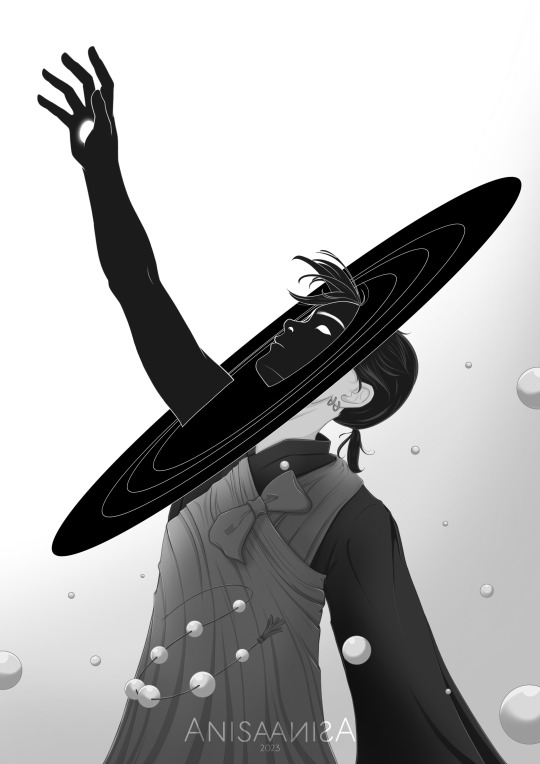



Drawtober 2023 (Now on AO3)
[Series Tag] [Art Tag] [FAQs Below the Cut]
Who: Hi I'm Anisa and I'm feral for feudal fairy tales :)
What: Drawtober is a label for a project that comprised of a theme, and a list of ideas. If you wanna see the thoughts behind those themes, I've attached some meta notes over on AO3. For nifty purposes.
When: Right now. I've also taken the liberty of compliling my 2023 Pride Month series in a similar format, and will likely continue to do so whenever the urge strikes/the shoe fits.
Where: Specifically on my Artnisa pseudoname. Previously, this was exclusive to collabs where I was the arteest and had no hand in the writing. I may choose to shift gears somewhere down the line, but for now, that's where they'll be.
Why: Fandom, as a contruct, is ever-changing, and Tumblr, the frontline of such a construct, is doing the most to kill desktop navigation whilst speed-running the Focus Theft Race; pair that with a testy search function, ever-evolving "porn bots" sniping tag usability, it can be a 'mare finding fanworks out there, in the Tumblr dot com wilds, let alone attempting to create some form of personal archive in the comfort of your own blog. So, as the Internet shifts, like all cultures do, it feels high time to start archiving properly. On the archive. For posterity and such.
How: Laughable that the only mention of this guide on Tumblr exists in the form of a button on the aformentioned desktop navigation, but here's a beginner friendly tutorial on how to add images to AO3 for any writers/artists that would like to learn how to do so. Plus some other fun stuff in and around it. Of course :D
Bonus Fun Fact: There's a black & white image under each post, though I added no context. When I'm done with something that toes the semi-realism lines like this lot, I like to turn RGB off to see how my values (light and shadows, essentially) turned out. I paint in colour, so seeing that the light was Just Right when said colour is no longer there to lean on is like a little reward. I just think they're neat. Thank you :)
Bonus Bonus Fact: There is a 753 word strong ficlet hidden in there, somwhere :3
Forehead smooches 💋🤸♂️
#ㄟ(≧◇≦)ㄏ#drawtober#posts to keep#as all ideas go i have percolated too long and went 110%#inuyasha#kagome#miroku#sango#kikyo#yura#inuyasha fanart#犬夜叉#animanga#fanart#artists on tumblr#and now on AO3#artnisa
135 notes
·
View notes
Note
hi, do you know any good books on being trans and trans rights and (anti) gender essentialism and stuff? only reading some of your posts has made me realise that i'm not as educated on this stuff as i feel i should be. i def have some mindsets that might even be kinda terf-y and i'm not proud of that and would like to learn more about it. google isn't giving me much and you seem like the kinda guy who has a rec list for everything haha, but absolutely no pressure (and if u have a kofi or smthing i'll happily donate for ur time ofc)
I do have a ko-fi if you feel so compelled. It’s linked in my blog description.
But if you wanna know more about queer issues in general and why in queer theory and gender theory definitions and solid categories aren’t really useful with the population as a whole I think that Queer: A Graphic History by Meg-John Barker is good for beginners. Barker has quite a few books on gender and sexuality, in fact. They’re alright at simplifying these overly academic concepts for a general audience.
If you’re interested in brain differences and lack thereof between the sexes, this video is a good introduction to some basic concepts and cites specific studies:
youtube
144 notes
·
View notes